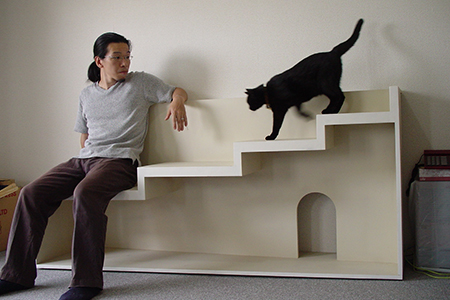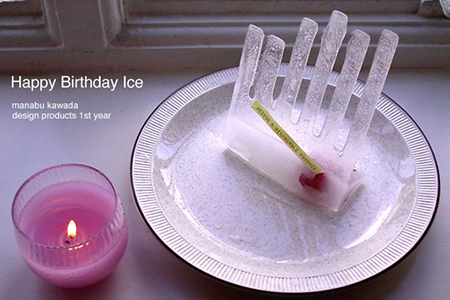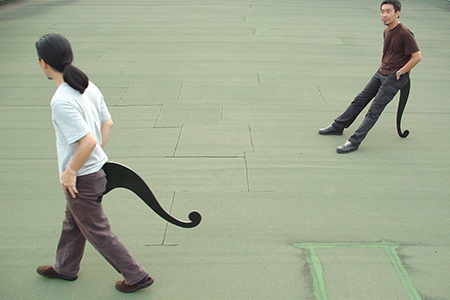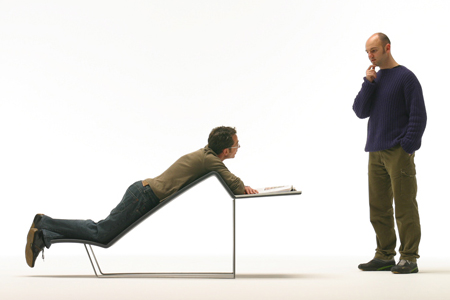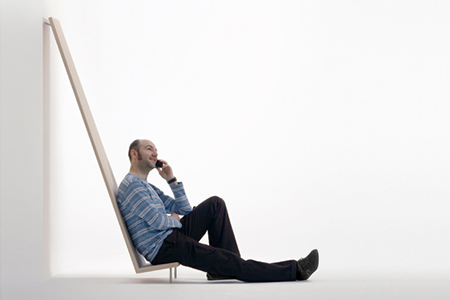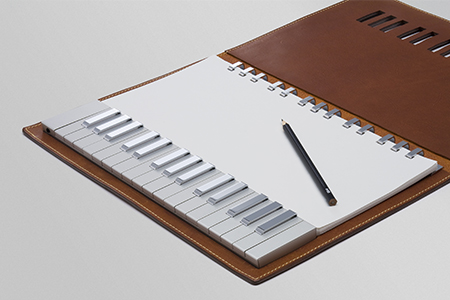General Manager of Design Laboratory Manabu Kawada
‐2‐
Working at Yamaha
Thinking about thinking
I enjoy thinking about the ways we think about things-designing the ways we design things. The first project I was in charge of after joining Yamaha was to design a ski. It's a tradition at the Yamaha Design Laboratory for new employees to be put in charge of a product of their own as soon as they join the company. It was a good experience in learning how to ask questions and how to think about how to approach designing this unfamiliar product.
Judging from my scrapbook from those days, I was absorbed in observing "ways of thinking"-thinking up methods of making magazine cutouts using ski-shaped holes cut in paper patterns, or noticing how the graphics on skis had much the same purpose as those on the packaging for cassette tapes. After that, I was put in charge of design for the Miburi, an electronic instrument with a completely novel method of playing; then professional karaoke machines; the DD Series compact digital drum kit; the Sound Station RP-U100 PC amp; and Banso-kun, an accompaniment data player for use during musical practice sessions. Apparently, whenever products I had been in charge of were released into the market, they wound up with the most unusual nicknames (laughs). With my style of blazing paths into new ways of thinking, I had the opportunity to work on quite a few new types of products.

The Backrest For Sky Viewers
My personal turning point was in my third year at Yamaha, when I submitted a proposal for a "standing chair-a backrest for looking at the sky" for our in-house idea contest. I received a special award from the president at the time, but the product itself was simply a piece of wood. Through experimentation, I discovered that when leaning back on the backrest to look at the sky, nothing but the sky would be in the user's field of vision at 15°, and the length of 2m 40cm allowed the user to pleasantly rock back and forth. I was delighted when the president told me, "At first I thought you were a bit off submitting that scrap of wood as your entry, but when I actually tried leaning back on it, I was impressed by the beautiful view of the sky-I haven't seen a view like that in years." Two years later, I entered this work under the title "The Backrest for Sky Viewers" in an art contest intended to provide moral support for children who had been exposed to radiation during the Chernobyl disaster, and it won the grand prize. As an additional prize, I received the opportunity to spend a month at a sanatorium in the city of Minsk in Belarus, where I had the extremely valuable experience of working with the children there to create works of art. Every day at the sanatorium I would take walks with the children to find places with good views of the sky, and we set up backrests at the locations of four different views. The children made up lovely names for each of them, like the "napping backrest" and the "backrest for waiting for the morning." This opportunity gave me a renewed appreciation for the value of creating.

The Katachi Lab and studying abroad in London
During the same period, I left my company dormitory and rented a place for myself as a studio of sorts, where I formed a group called the Katachi Lab centered around my colleagues from the Design Laboratory. As we shared with each other the things we thought about every day, we started designing various things that we wanted to see and to present them to the public at large, which led to us holding a group exhibition called Fudan-gu at the OZONE gallery in Shinjuku in 1998. Fudan-gu was our name for objects designed for use in everyday life, not merely for decoration. What made me happy at the time was the support we received from the previous director of the Design Laboratory, who encouraged us to pursue these "extracurricular activities" even further. He supported the designers in pushing themselves to deepen their relationships with craftsmanship and to engage the outside world. I love this type of environment, and I hope to carry it on. After that, in 2001, I had the opportunity to study at the Royal College of Art (RCA) in London for two years. The RCA is a graduate-level institution, where designers of the same generation with a certain amount of experience could come together from around the world in order to broaden their horizons while further carving out their identities as designers. During my two-year study period I presented new works in a total of eight exhibitions in England, the Netherlands, Italy, Sweden, and Scotland, where I talked about what I was pursuing as a designer. I think what I learned from my experience studying abroad was that the only way to strengthen one's identity is to actively engage the outside world, through concrete actions taken one by one, in order to gain a new understanding of one's own uniqueness from different perspectives, thus further deepening one's thought. While my focus has increased in scope from my own identity to that of the Yamaha brand, the fundamental philosophy behind my activities has remained constant even after my return to Japan-I think the Yamaha Design exhibit on display at the Milano Salone since 2005 perfectly encapsulates this philosophy.

